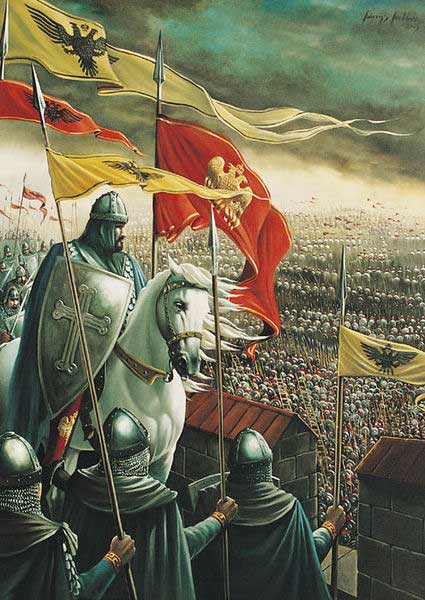.

Constantine XI Paleologus
Constantine XI Palaiologos or Palaeologus (Greek: Κωνσταντίνος ΙΑ' Δραγάσης Παλαιολόγος, Kōnstantinos XI Dragasēs Palaiologos), (February 8, 1405[1] – May 29, 1453) was the last reigning Emperor of the Byzantine Empire, from 1448 to his death.
Constantine was born in Constantinople as the eighth of ten children of Manuel II Palaiologos and Helena Dragaš, the daughter of the Serbian prince Constantine Dragaš of Kumanovo. In a variant of the Byzantine practice of adopting the distaff surname where it connoted more prestige, Constantine liked to be known by his mother's name of Dragaš (Serbian: Драгаш) or Dragasēs, which she inherited from her Serbian father. He spent most of his childhood in Constantinople under the supervision of his parents. During the absence of his older brother in Italy, Constantine was regent in Constantinople from 1437 to 1439.
Constantine became the Despotes of Morea (the Medieval name for the Peloponnesus) in 1443 which he ruled from the palace in Mistra. In 1443, he launched an invasion of the Latin Duchy of Athens from Morea, swiftly conquering Thebes and Athens and forcing its Florentine duke to pay him tribute. However, his triumph was short-lived, as the Ottomans soon intervened and drove him back into Morea.
Constantine XI married twice: the first time on July 1, 1428 to Maddalena Tocco, niece of Carlo I Tocco of Epirus, who died in November 1429; the second time to Caterina Gattilusio, daughter of the Genoese lord of Lesbos, who also died (1442). Some sources record that he had no children by either marriage, others that he had one daughter, Magdalena.
When his brother, Emperor John VIII Palaiologos, died, a dispute erupted between Constantine and his brother Demetrios Palaiologos over the throne. They appealed to the Ottoman Sultan Murad II to arbitrate the disagreement. He chose Constantine, who was crowned at Mistra on January 6, 1449. Constantine XI attempted to marry a distant cousin, Maria Branković, the widow of Murad II, but the courtship failed. Soon afterwards, Sultan Mehmed II began agitating for ownership of Constantinople. Desperate for any type of military assistance, Constantine XI appealed to the West, but he was refused help unless he united the Orthodox Church with the Roman Catholic Church, which was a policy pursued by his predecessors. He declared the churches united after the Council of Florence in 1452, but the union was overwhelmingly rejected by his subjects and it dangerously estranged him from his chief minister and military commander, the Megas Doux Loukas Notaras.
Mehmed II offered Constantine XI the chance to rule in Mistra before the siege of Constantinople, but he refused, preferring to fight and die defending his empire. His wish to die in defence of the Empire would come true, as he was killed while defending the gates of Constantinople on May 29, 1453. The Emperor, when realising that the end had come ("The City is fallen but I am alive"), discarded his purple cloak and charged into the breach. Some sources record that he was only recognized afterwards by his purple boots, and others that the Turks were never able to identify his body, and so the last Emperor of Rome was buried in a mass grave along with his soldiers.
A legend refers to the Marble King, Constantine XI, holding that, when the Ottomans entered the city, an angel rescued the emperor, turned him into marble and placed him in a cave under the earth near the Golden Gate, where he waits to be brought to life again.[2][3].
Orthodox Christians consider Constantine XI a saint, but he has not been officially recognized as such. However, his bravery and last stand are seen by many as a great heroic act. Additionally, in the centuries of Ottoman rule, any effort on the part of the Orthodox Church to officially glorify Constantine XI as a saint would have been seen as an act of rebellion, and hence decidedly ill-advised. After the Greek War of Independence (1821-1831), when the Greek Orthodox Church once again had freedom to act, an official act of glorification was thought to be superfluous, on account of longstanding veneration as a saint and martyr, specifically, an ethnomartyr, Greek ἐθνομάρτυρας. However, the erection of the statue of "Saint Constantine XI the Ethnomartyr" in the Cathedral Square in Athens, with the formal blessing of the Church authorities, appears to be a semi-official act of recognition. His feast falls on 29 May.
Never having repudiated his union with Rome, and dying in full communion with Rome, having received Holy Communion at the hands of Cardinal Isidore of Kiev only a few hours before his death, he technically died a Greek-Catholic, and for this reason he is also venerated by Eastern Catholics.

Greek Stamp of Constantine XI

Constantine XI, the last Byzantine Emperor at the battlements, dawn of the 29th May of 1453, 200 X 145 cm,- oil on canvas, 2003 by Iannis Nikou
Bibliography
- Donald M. Nicol, The Immortal Emperor : The Life and Legend of Constantine Palaiologos, Last Emperor of the Romans
; Cambridge University Press, 1992; ISBN 0-521-46717-9
- Steven Runciman: The Fall of Constantinople, 1453
. CUP. ISBN 0521398320
- David Nicole: Constantinople 1453
Osprey Publishing. 2000. ISBN 1 84176 091 9
--------------------------------------------------------------------------------
Preceded by: Theodore II Palaiologos
Ruler of Morea 1443–1449
Succeeded by: Demetrios Palaiologos and Thomas Palaiologos
Preceded by: John VIII Palaiologos
Byzantine Emperor 1448 –1453
Succeeded by: Demetrios Palaiologos and Thomas Palaiologos
| Ancient Greece
Science, Technology , Medicine , Warfare, , Biographies , Life , Cities/Places/Maps , Arts , Literature , Philosophy ,Olympics, Mythology , History , Images Medieval Greece / Byzantine Empire Science, Technology, Arts, , Warfare , Literature, Biographies, Icons, History Modern Greece Cities, Islands, Regions, Fauna/Flora ,Biographies , History , Warfare, Science/Technology, Literature, Music , Arts , Film/Actors , Sport , Fashion --- |
Retrieved from "http://en.wikipedia.org"
All text is available under the terms of the GNU Free Documentation License

